
Olive Oyl is a cartoon character created by E. C. Segar in 1919 for his comic strip Thimble Theatre. The strip was later renamed Popeye after the sailor character that became the most popular member of the cast; however, Olive Oyl was a main character for a decade before Popeye's 1929 appearance.

Bluto, at times known as Brutus, is a cartoon and comics character created in 1932 by Elzie Crisler Segar as a one-time character, named "Bluto the Terrible", in his Thimble Theatre comic strip. Bluto made his first appearance on September 12 of that year. Fleischer Studios adapted him the next year (1933) to be the main antagonist of their theatrical Popeye animated cartoon series.
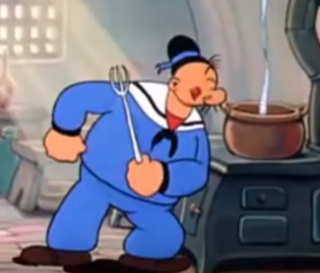
J. Wellington Wimpy, generally referred to as Wimpy, is a character in the comic strip Popeye, created by E. C. Segar, and in the Popeye cartoons based upon the strip. Wimpy debuted in the strip in 1931 and was one of the dominant characters in the newspaper strip, but when Popeye was adapted as an animated cartoon series by Fleischer Studios, Wimpy became a minor character; Dave Fleischer said that the character in the original Segar strip was "too smart" to be used in the film cartoon adaptations. Wimpy appears in Robert Altman's 1980 live-action musical film Popeye, played by Paul Dooley.

Popeye is a 1982 platform game developed and released by Nintendo as an arcade video game. It is based on the comic strip of the same name created by E. C. Segar and licensed from King Features Syndicate. Some sources claim that Ikegami Tsushinki did programming work on the game. As Popeye, the player must collect hearts thrown by Olive Oyl from the top of the screen while being chased by Bluto. Popeye can punch bottles thrown at him, but can only hurt Bluto after eating the one can of spinach present in each level. Unlike Nintendo's earlier Donkey Kong games, there is no jump button. There are three screens.
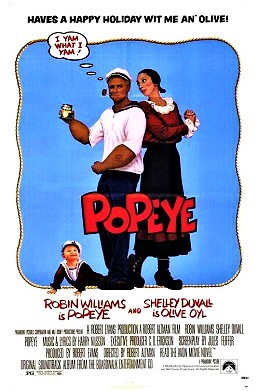
Popeye is a 1980 American musical comedy film directed by Robert Altman and produced by Paramount Pictures and Walt Disney Productions. It is based on E. C. Segar's Popeye comics character. The script was written by Jules Feiffer, and stars Robin Williams as Popeye the Sailor Man and Shelley Duvall as Olive Oyl. Its story follows Popeye's adventures as he arrives in the town of Sweethaven.

Popeye the Sailor Meets Sindbad the Sailor is a 1936 two-reel animated cartoon short subject in the Popeye Color Specials series, produced in Technicolor and released to theatres on November 27, 1936, by Paramount Pictures. It was produced by Max Fleischer for Fleischer Studios and directed by Dave Fleischer, with the title song's music composed by Sammy Timberg and lyrics written by Bob Rothberg. The voice cast includes Jack Mercer as Popeye, Gus Wickie as Sindbad the Sailor, Mae Questel as Olive Oyl and Lou Fleischer as J. Wellington Wimpy.

Popeye the Sailor Meets Ali Baba's Forty Thieves is a two-reel animated cartoon short subject in the Popeye Color Specials series, produced in Technicolor and released to theatres on November 26, 1937 by Paramount Pictures. It was produced by Max Fleischer for Fleischer Studios, Inc. and directed by Dave Fleischer. Willard Bowsky was head animator, with musical supervision by Sammy Timberg. The voice of Popeye is performed by Jack Mercer, with additional voices by Mae Questel as Olive Oyl, Lou Fleischer as J. Wellington Wimpy and Gus Wickie as Abu Hassan.
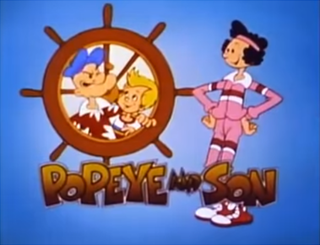
Popeye and Son is an American animated comedy series based on the Popeye comic strip created by E.C. Segar and published by King Features Syndicate. Jointly produced by Hanna-Barbera and King Features subsidiary King Features Entertainment, the series aired for one season of thirteen episodes on CBS from September 19 to December 12, 1987. It is a follow-up to The All New Popeye Hour. Due to Jack Mercer's death in 1984, Maurice LaMarche voiced Popeye, while much of the cast of The All New Popeye Hour reprised their respective roles, with the exception of Daws Butler. However, Nancy Cartwright, who was trained by Butler, voiced Woody in the series.

Popeye's Voyage: The Quest for Pappy is a 2004 animated Christmas television special produced by Mainframe Entertainment for Lions Gate Entertainment and King Features Entertainment, in association with Nuance Productions. The special, created to coincide with the 75th anniversary of the Popeye the Sailor comic strip character from E. C. Segar's Thimble Theatre, first aired on Fox on December 17, 2004, and was rebroadcast on the same network on December 30, 2005.
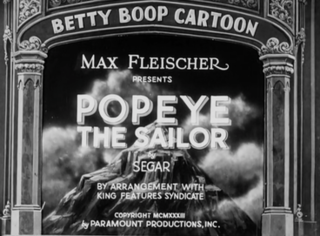
Popeye the Sailor is a 1933 animated short produced by Fleischer Studios and distributed by Paramount Publix Corporation. While billed as a Betty Boop cartoon, it was produced as a vehicle for Popeye in his debut animated appearance.

I Yam What I Yam is the second Popeye theatrical cartoon short, starring Billy Costello as Popeye, Bonnie Poe as Olive Oyl and Charles Lawrence as Wimpy. The source of the quote is the comic strip, Thimble Theatre by E. C. Segar, in which Popeye first appeared. This is a paraphrase of words spoken by Popeye in the comic strip.

Popeye the Sailor is an American animated television series produced for King Features Syndicate TV starring Popeye that was released between 1960 and 1963 with 220 episodes produced. The episodes were produced by multiple animation studios and aired in broadcast syndication until the 1990s.

The All New Popeye Hour is an American animated television series produced by Hanna-Barbera Productions and King Features Entertainment. Starring the comic strip character Popeye, the series aired from 1978 to 1983 Saturday mornings on CBS. Despite the series' mixed reception, it was a hit for King Features Entertainment.

You're a Sap, Mr. Jap is a 1942 one-reel anti-Japanese Popeye the Sailor animated cartoon short subject released by Paramount Pictures on August 7, 1942. It was the first cartoon short to be produced by Famous Studios. It is one of the best-known World War II propaganda cartoons.

Popeye the Sailor is a fictional cartoon character created by Elzie Crisler Segar. The character first appeared on January 17, 1929, in the daily King Features comic strip Thimble Theatre. The strip was in its tenth year when Popeye made his debut, but the one-eyed sailor quickly became the lead character, and Thimble Theatre became one of King Features' most popular properties during the 1930s. Following Segar's death in 1938, Thimble Theatre was continued by several writers and artists, most notably Segar's assistant Bud Sagendorf. The strip continues to appear in first-run installments on Sundays, written and drawn by R. K. Milholland. The daily strips are reprints of old Sagendorf stories.

Blow me Down! is a Popeye theatrical cartoon short in the Paramount Picture short series. It was released in 1933 and was the third cartoon in the Popeye the Sailor series of theatrical cartoons released by Paramount Pictures. The title also corresponds to one of Popeye's most notable catchphrases.

Seasin's Greetinks! is a Popeye theatrical Christmas-themed cartoon short, starring Billy Costello as Popeye and Bonnie Poe as Olive Oyl and William Pennell as Bluto. It was released on December 17, 1933 and is in the Popeye the Sailor series of theatrical cartoons released by Paramount Pictures.

Popeye is a Japan-exclusive Game Boy video game based on the comic strip of same name licensed from King Features Syndicate.
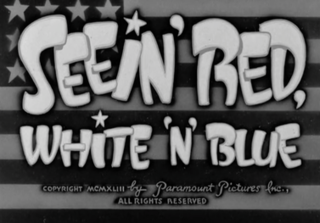
Seein' Red, White 'N' Blue is a 1943 American propaganda cartoon short featuring Popeye directed by Dan Gordon and Jim Tyer. The cartoon revolves around Bluto trying to escape the draft but ends up fighting alongside Popeye against some Japanese spies, Hirohito and Adolf Hitler.
Ancient Fistory is a 1953 American animated short film directed by Seymour Kneitel and starring Jack Mercer in multiple roles. The film was released by Paramount Pictures on January 30, 1953. It was based on a gender-reversed parody of the fairy tale Cinderella and a possible inspiration for the 1960 filmCinderfella starring Jerry Lewis.


















